- S.D. Eibar ready for maiden La Liga outing
- SD Eibar stengthen ahead of debut La Liga season
- Can ‘Super Mario’ live up to expectations in Madrid?
- MAN IN THE GROUND – Brentford 0 – 4 Osasuna
- Historic Basque derby welcomes S.D. Eibar to La Liga
- Munich to Madrid, via Brazil – Tony Kroos
- Rakitic in Spanish Switch
- Can Spain find redemption in Rio?
- Viva Espana! A season of redemption for Spanish football
- From the old to the new: who can fill the void in years to come for La Roja?
Barcelona’s Hidden Gems: Mini Estadi and Nou Sardenya
- Updated: 26 February, 2012

Last week FC Barcelona announced that their club museum had attracted a record 1.6 million visitors during 2011. It is a fabulous exhibition and an absolute feast for any football fan. However, if you look beyond the towering walls of the Camp Nou, the city of Barcelona will provide the travelling football fan with a host of tantalising appetisers, all of which have their own rich ingredients.
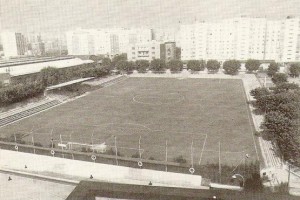 The first stadium to visit is on the Camp Nou’s doorstep, but is often overlooked. Opened in September 1982, the Mini Estadi was designed by local architect Josep Casals and seats 15,276 over two tiers. It makes a stunning statement about the size of the FC Barcelona – Here is a club with 110,000 members, sports sections that are among the best in Europe and their Reserve Team play in a purpose built, all-seater stadium.
The first stadium to visit is on the Camp Nou’s doorstep, but is often overlooked. Opened in September 1982, the Mini Estadi was designed by local architect Josep Casals and seats 15,276 over two tiers. It makes a stunning statement about the size of the FC Barcelona – Here is a club with 110,000 members, sports sections that are among the best in Europe and their Reserve Team play in a purpose built, all-seater stadium.
In its heyday the stadium has seen full houses, such as in the Copa del Rey in 1984 when Barça B drew 0-0 with Real Madrid and Andorra’s international matches against Holland & The Republic of Ireland. Queen, Elton John & David Bowie have all packed out the Mini Estadi, although the ill-fated attempt to bring American Football to Europe, failed to tempt the Catalan public to the Mini Estadi and the Barcelona Dragons folded in 2003. With Barça B now back in La Segunda, the exploits of the youngsters have attracted decent crowds to the Mini Estadi, with an average gate of 6,000 in recent seasons.
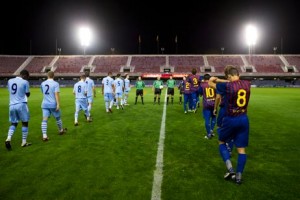 You can usually gain access to the stadium on a non-match day by speaking to the security guards who man a booth on the north side of the stadium. It is strikingly similar in design to two other stadiums that were built at the time, CD Castellon’s Nou Castalia and FC Cartagena’s Estadio Cartagonova. Whilst most clubs would bite your hand off for such a stadium, I have to say it is looking a tad tired. Quite a few seats are either broken or working lose from their moorings, and all of them have faded in the Catalan sun. Talk of selling the ground for housing has been put on the back-burner, but you can’t help feeling that its days are numbered. Will Barça stay true to their roots or follow the lead of so many other La Liga clubs and base the B team at the club’s out of town Ciudad de Esports? If I was you, I’d catch it while you can.
You can usually gain access to the stadium on a non-match day by speaking to the security guards who man a booth on the north side of the stadium. It is strikingly similar in design to two other stadiums that were built at the time, CD Castellon’s Nou Castalia and FC Cartagena’s Estadio Cartagonova. Whilst most clubs would bite your hand off for such a stadium, I have to say it is looking a tad tired. Quite a few seats are either broken or working lose from their moorings, and all of them have faded in the Catalan sun. Talk of selling the ground for housing has been put on the back-burner, but you can’t help feeling that its days are numbered. Will Barça stay true to their roots or follow the lead of so many other La Liga clubs and base the B team at the club’s out of town Ciudad de Esports? If I was you, I’d catch it while you can.
Next up is a trip to the northern district of Gracia and the Nou Sardenya, home to one of Spain’s most historic, but probably forgotten clubs. Club Esportiu Europa was founded in 1907 following the merger of Madrid de Barcelona and Provençal. It has played at several grounds prior to its move to Gracia in 1940, including one at Calle Marina, in the shadows of the Sagrada Familia. Club legend has it that Antoni Gaudí would watch the team train whilst working on his masterpiece.
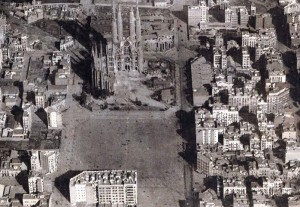 Europa along with FC Barcelona, were the dominant forces in Catalan football in the 1920’s. Their golden season occurred in 1922-23 when the club won the Championat de Catalunya and reached the final of the Copa del Rey, only to lose 0-1 to Athletic Bilbao at Barcelona’s Les Corts stadium. Under tutelage of Englishman Ralph Kirby, the club also finished second in the Campionat on six occasions and based on this success, it was invited to take part in the inaugural season of the Spanish Football League.
Europa along with FC Barcelona, were the dominant forces in Catalan football in the 1920’s. Their golden season occurred in 1922-23 when the club won the Championat de Catalunya and reached the final of the Copa del Rey, only to lose 0-1 to Athletic Bilbao at Barcelona’s Les Corts stadium. Under tutelage of Englishman Ralph Kirby, the club also finished second in the Campionat on six occasions and based on this success, it was invited to take part in the inaugural season of the Spanish Football League.
Europa narrowly missed relegation in the first two seasons, but eventually fell to La Segunda in 1930-31. This coincided with a financial crisis which saw the club merge with Gràcia FC to form Catalunya FC for the 1931-32 season. It was not a marriage made in heaven and the club folded before the end of the season. Europa went to play in the amateur leagues, and on 1 December 1940 opened the original ground on the Carrer de Sardenya. It was a basic arena of terracing with a dirt pitch, but three years later the club built a 1,000 seater grandstand from the proceeds of the transfer of Antoni Ramalletts to FC Barcelona. Not a great deal changed over the next 45 years, then in the 1980’s, the urban sprawl of Barcelona began to strangle the ageing Camp Sardenya and with the construction of the northern ring-road, the club saw some of its offices and terracing reduced. Finally in the early 1990’s, the municipality decided to completely redevelop the site and Camp Sandenya was demolished. For three seasons, the club played its home matches at UE Sant Andreu’s Narcis Sala stadium and UE Sants’ Camp Magòria. However, what the club returned to was a vast improvement on Camp Sardenya and an ingenious piece of urban architecture.
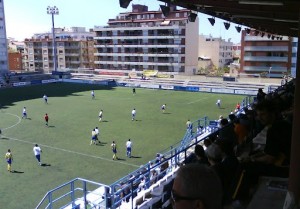 Officially opened on 4 May 1995, Nou Sardenya occupies the site of the former ground, only it is approximately 5 metres higher. That is down to the fact that the stadium sits on top of a municipal sports centre and underground car park. Along the north side of the ground is a modern 1,144 seat cantilevered stand, whilst five steps of blue and white terracing surround the remainder of the ground. Not an inch of space is wasted as the club offices sit in the vaults under the west terrace.
Officially opened on 4 May 1995, Nou Sardenya occupies the site of the former ground, only it is approximately 5 metres higher. That is down to the fact that the stadium sits on top of a municipal sports centre and underground car park. Along the north side of the ground is a modern 1,144 seat cantilevered stand, whilst five steps of blue and white terracing surround the remainder of the ground. Not an inch of space is wasted as the club offices sit in the vaults under the west terrace.
The whole complex still looks spruce and when I visited it last year, it was being utilised by every conceivable age-group. The club offices are open week days from 11am, and if you ask nicely, they will let you have a look around the stadium. Europa is a genuine community club that is proud of its history, but still wants to make its mark as a football club. Just as they did in 1997 & 1998 when they beat FC Barcelona, containing the likes of Stoichkov, de la Pena, Couto, Sergi & Reiziger, to win the Copa Catalunya.
Follow @icentrocampista

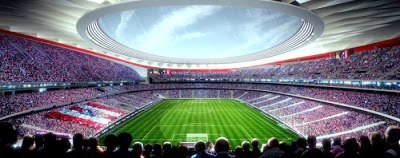
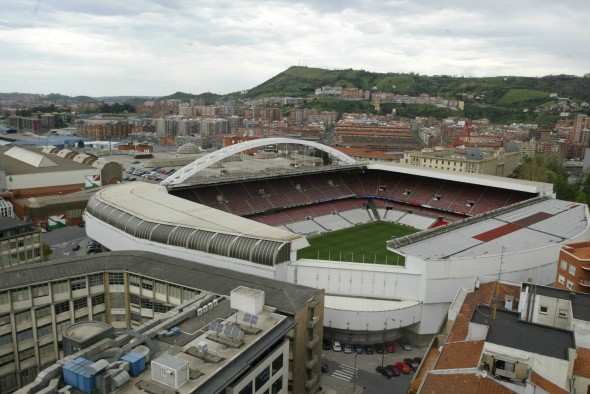
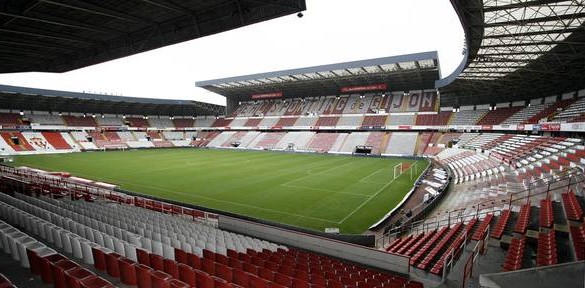


You must be logged in to post a comment Login